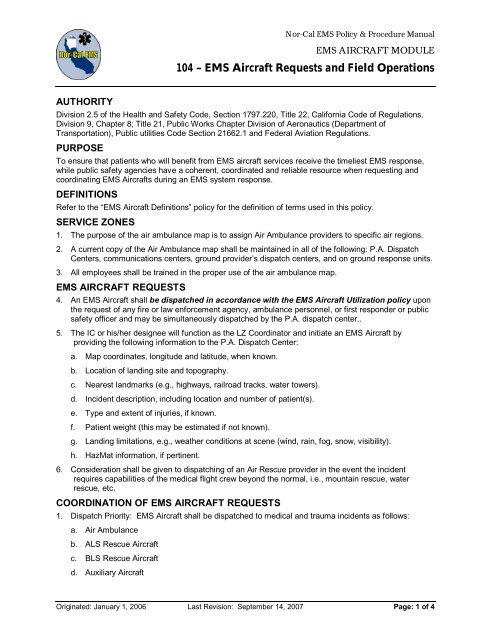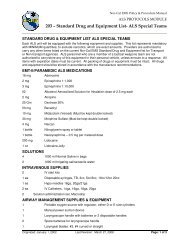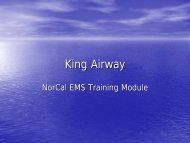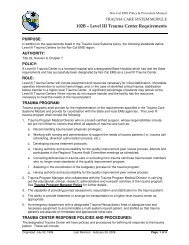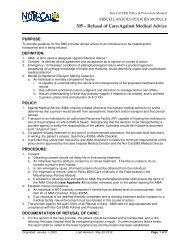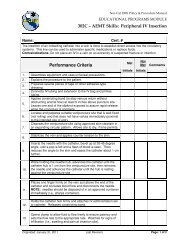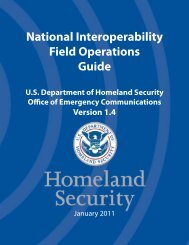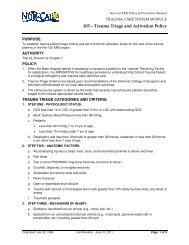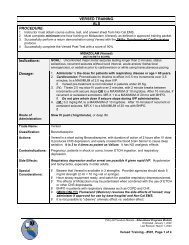Policy and Procedure Manual - Northern California Emergency ...
Policy and Procedure Manual - Northern California Emergency ...
Policy and Procedure Manual - Northern California Emergency ...
You also want an ePaper? Increase the reach of your titles
YUMPU automatically turns print PDFs into web optimized ePapers that Google loves.
Nor-Cal EMS <strong>Policy</strong> & <strong>Procedure</strong> <strong>Manual</strong><br />
EMS AIRCRAFT MODULE<br />
104 – EMS Aircraft Requests <strong>and</strong> Field Operations<br />
AUTHORITY<br />
Division 2.5 of the Health <strong>and</strong> Safety Code, Section 1797.220, Title 22, <strong>California</strong> Code of Regulations,<br />
Division 9, Chapter 8; Title 21, Public Works Chapter Division of Aeronautics (Department of<br />
Transportation), Public utilities Code Section 21662.1 <strong>and</strong> Federal Aviation Regulations.<br />
PURPOSE<br />
To ensure that patients who will benefit from EMS aircraft services receive the timeliest EMS response,<br />
while public safety agencies have a coherent, coordinated <strong>and</strong> reliable resource when requesting <strong>and</strong><br />
coordinating EMS Aircrafts during an EMS system response.<br />
DEFINITIONS<br />
Refer to the “EMS Aircraft Definitions” policy for the definition of terms used in this policy.<br />
SERVICE ZONES<br />
1. The purpose of the air ambulance map is to assign Air Ambulance providers to specific air regions.<br />
2. A current copy of the Air Ambulance map shall be maintained in all of the following: P.A. Dispatch<br />
Centers, communications centers, ground provider’s dispatch centers, <strong>and</strong> on ground response units.<br />
3. All employees shall be trained in the proper use of the air ambulance map.<br />
EMS AIRCRAFT REQUESTS<br />
4. An EMS Aircraft shall be dispatched in accordance with the EMS Aircraft Utilization policy upon<br />
the request of any fire or law enforcement agency, ambulance personnel, or first responder or public<br />
safety officer <strong>and</strong> may be simultaneously dispatched by the P.A. dispatch center..<br />
5. The IC or his/her designee will function as the LZ Coordinator <strong>and</strong> initiate an EMS Aircraft by<br />
providing the following information to the P.A. Dispatch Center:<br />
a. Map coordinates, longitude <strong>and</strong> latitude, when known.<br />
b. Location of l<strong>and</strong>ing site <strong>and</strong> topography.<br />
c. Nearest l<strong>and</strong>marks (e.g., highways, railroad tracks, water towers).<br />
d. Incident description, including location <strong>and</strong> number of patient(s).<br />
e. Type <strong>and</strong> extent of injuries, if known.<br />
f. Patient weight (this may be estimated if not known).<br />
g. L<strong>and</strong>ing limitations, e.g., weather conditions at scene (wind, rain, fog, snow, visibility).<br />
h. HazMat information, if pertinent.<br />
6. Consideration shall be given to dispatching of an Air Rescue provider in the event the incident<br />
requires capabilities of the medical flight crew beyond the normal, i.e., mountain rescue, water<br />
rescue, etc.<br />
COORDINATION OF EMS AIRCRAFT REQUESTS<br />
1. Dispatch Priority: EMS Aircraft shall be dispatched to medical <strong>and</strong> trauma incidents as follows:<br />
a. Air Ambulance<br />
b. ALS Rescue Aircraft<br />
c. BLS Rescue Aircraft<br />
d. Auxiliary Aircraft<br />
Originated: January 1, 2006 Last Revision: September 14, 2007 Page: 1 of 4
EMS AIRCRAFT MODULE EMS Aircraft Requests <strong>and</strong> Field Operations # 104<br />
2. P.A. Dispatch Center:<br />
a. May simultaneously dispatch an EMS Aircraft with the ground unit response when the<br />
incident/patient information meets the criteria listed in the EMS Aircraft Utilization policy.<br />
b. Shall dispatch the appropriate EMS Aircraft provider via the Communication Center’s designated<br />
telephone line. Within the Shasta County region, REACH <strong>and</strong> PHI share the common dispatch<br />
number (530) 245-6700, which is rotated between services every 24 hours at 0600.<br />
c. Shall dispatch scene calls with private requests, as follows:<br />
‣ Single Provider: Request the closest Air Ambulance in areas with a single air ambulance<br />
provider regardless of patient request (patient preference).<br />
‣ Multiple Providers: Request the appropriate Air Ambulance on rotation, unless a private<br />
request (patient preference) has been expressed prior to liftoff.<br />
d. Shall dispatch an EMS Aircraft immediately upon request from a ground ambulance while en<br />
route to an emergency.<br />
3. The Communications Center is responsible for dispatch, flight following, <strong>and</strong> providing accurate<br />
ETAs. Any delay or an update of response is to be communicated immediately to ground providers.<br />
When an EMS Aircraft arrives at scene greater than five (5) minutes from the ETA provided,<br />
the prehospital care provider shall complete <strong>and</strong> submit an Unusual Occurrence Report,<br />
located in the Provider Requirements Module.<br />
ALS AIR RESCUE TRANSPORT<br />
1. ALS Air Rescues may provide medical air transport of the ill <strong>and</strong> injured from scene calls to<br />
appropriate medical facilities when the delay in Air Ambulance transportation is reasonably likely to<br />
compromise patient care <strong>and</strong> outcome. This is only applicable when the ALS Air Rescue is the first<br />
on scene, is the primary care giver, <strong>and</strong> an Air Ambulance is unavailable or not immediately available.<br />
Efforts shall be made by the ALS Air Rescue to turn patient transportation over to air ambulances<br />
when safety <strong>and</strong> patient condition permits.<br />
a. References: <strong>California</strong> H & S Code, Section 1798.6, <strong>California</strong> Penal Code, Section 409.3, <strong>and</strong><br />
Nor-Cal EMS’s Responsibility for Patient Management <strong>Policy</strong>.<br />
b. Prior to moving the patient, an ALS Air Rescue, shall make attempts to obtain the ETA of the air<br />
ambulance from an appropriate source (e.g., incident comm<strong>and</strong>er (IC), P.A. Dispatch Center,<br />
responding ground ambulance, or responding air ambulance).<br />
c. When the patient is transported by the ALS Air Rescue, the source where the ETA of the air<br />
ambulance was obtained by the ALS Rescue personnel shall be documented in the PCR.<br />
PCR’s for those patients who were transported by ALS Air Rescue shall be submitted to Nor-Cal<br />
EMS on a monthly basis.<br />
GROUND AMBULANCE RESPONSE<br />
1. A ground ambulance shall respond to a scene call when an EMS Aircraft has been dispatched (this<br />
does not include private calls to clinics, medical facility, or physician’s office).<br />
2. The ground ambulance unit responding to, or at the scene, shall not be canceled until:<br />
a. The EMS Aircraft has left the scene with the patient aboard, or<br />
b. The senior medical person on-scene has determined that patient transport is not required per the<br />
EMS Aircraft Utilization policy.<br />
3. A ground unit paramedic, who accompanies a patient in an Air Rescue shall assure the presence of<br />
appropriate medical equipment <strong>and</strong> obtain orientation to the aircraft.<br />
AIR COMMUNICATIONS<br />
1. Providers are hereby authorized to utilize the Nor-Cal EMS UHF radio channels for EMS<br />
coordination, dispatching of ambulances <strong>and</strong> providing patient reports, see the Communication <strong>Policy</strong><br />
located in the Miscellaneous Policies Module.<br />
2. Air to Air: Shall be conducted on 123.025.<br />
Originated: January 1, 2006 Last Revision: September 14, 2007 Page: 2 of 4
EMS AIRCRAFT MODULE EMS Aircraft Requests <strong>and</strong> Field Operations # 104<br />
3. Air to Ground:<br />
a. If an air to ground frequency has not been established prior to dispatch, CALCORD (156.075)<br />
shall be utilized as the initial air-to-ground contact coordination frequency. If CALCORD is busy,<br />
the first choice shall be Med Alpha (155.340), sometimes known as “Old Med Net.”<br />
b. When CALCORD is utilized as the initial frequency, the IC or designee may direct subsequent<br />
medical traffic to an alternate frequency as specified.<br />
4. Air to Receiving Facility: Patient report shall be provided to the Receiving Facility on the channel<br />
outlined in the Receiving Facility Channels policy, located in the Miscellaneous Policies Module.<br />
5. Notification: When a helicopter needs to utilize a helispot or helipad, notification <strong>and</strong> coordination<br />
shall be made with the organization or person responsible for that l<strong>and</strong>ing site.<br />
LANDING ZONE MANAGEMENT<br />
Designation of L<strong>and</strong>ing Sites:<br />
1. Identify an <strong>Emergency</strong> Medical Services L<strong>and</strong>ing Site that has been designated an EMS l<strong>and</strong>ing site<br />
by an officer authorized by a public safety agency using guidelines outlined in Appendix A <strong>and</strong> any<br />
criteria that the public safety agency has determined is reasonable <strong>and</strong> prudent for the safe<br />
operations of EMS helicopters.<br />
2. This l<strong>and</strong>ing site may be used, over any twelve month period, for no more than an average of six<br />
l<strong>and</strong>ings per month with a patient or patients on the helicopter, except to allow for adequate medical<br />
response to a mass casualty even if that response causes the site to be used beyond these limits.<br />
3. Is not marked as a permitted heliport as described in Section 3554 of Title 21; <strong>and</strong> (4) is used only for<br />
emergency medical purposes.<br />
4. EMS Aircraft Staffing: If the EMS Aircraft is permitted by the provider agreement to be staffed with<br />
either BLS or ALS personnel, per their classification <strong>and</strong>/or provider agreement, it is the responsibility<br />
of the EMS Aircraft to notify the LZ Coordinator of their current staffing prior to l<strong>and</strong>ing, to assure that<br />
adequate resources are available to the patient(s).<br />
5. See Appendix A for L<strong>and</strong>ing Zone Setup <strong>and</strong> Safety.<br />
PATIENT DESTINATION<br />
EMS Aircraft shall transport patient(s) according the Patient Destination <strong>Policy</strong>, located in the<br />
Miscellaneous Policies Module.<br />
HELICOPTER RENDEZVOUS<br />
1. The ground ambulance may consider initiation of ground transport with an EMS aircraft rendezvous if<br />
the patient is ready for evacuation <strong>and</strong> the air ambulance is not overhead or on scene. The IC or<br />
designee with either the P.A. Dispatch Center or the communication center shall coordinate the<br />
rendezvous.<br />
2. The highest medical person in charge of the patient should avoid multiple attempts in rendezvousing<br />
with EMS Aircraft, if the individual in charge of patient care determines that further delays are not in<br />
the medical best interest of the patient.<br />
3. When a safe l<strong>and</strong>ing site in proximity to the patient is not available at the incident:<br />
a. The IC or designee shall consider arranging for an EMS aircraft rendezvous at an appropriate<br />
location. The IC or designee in coordination with the ground ambulance (if communications<br />
allow) shall select a rendezvous site.<br />
b. If the rendezvous site is not an approved helipad or airfield l<strong>and</strong>ing site, the request for the EMS<br />
aircraft rendezvous shall be h<strong>and</strong>led in the same manner as a request for an EMS aircraft to the<br />
scene. A public safety agency shall be on the scene at the rendezvous site.<br />
4. Rendezvous at an approved helipad or airfield-l<strong>and</strong>ing site does not require presence of law<br />
enforcement or fire personnel.<br />
5. Once the ground ambulance is enroute, the ambulance crew should consider initiation a helicopter<br />
rendezvous when:<br />
Originated: January 1, 2006 Last Revision: September 14, 2007 Page: 3 of 4
EMS AIRCRAFT MODULE EMS Aircraft Requests <strong>and</strong> Field Operations # 104<br />
a. Patient condition deteriorates<br />
b. Traffic conditions are impassable<br />
c. Ground unit develops mechanical failure, or<br />
d. Factors exist that will cause a delay or potentially negative outcome in patient transport.<br />
e. In all instances, consideration should be given to possible ground transport to a closer facility.<br />
6. When a hospital-operated ambulance is transporting a trauma patient (meets Nor-Cal EMS Trauma<br />
Triage Criteria) to a Trauma Center per the Patient Destination policy, an ambulance may utilize a<br />
helipad at a RF without the patient receiving a medical screening exam (MSE), for transport to a<br />
more distant Trauma Center.<br />
a. If a physician comes out to meet the patient at the helipad, s/he is then obligated to stabilize <strong>and</strong><br />
transfer out per the requirements listed in the Interfacility Transfer policy in the Facility<br />
Requirements Module.<br />
b. If, however, while at the helipad, the pts. condition deteriorates, the hospital at which the helipad<br />
is located shall provide another MSE <strong>and</strong> stabilizing treatment within its capacity if requested by<br />
the transporting personnel.<br />
CANCELLING AN EMS AIRCRAFT REQUEST<br />
1. Cancellation of EMS Aircraft may occur due to:<br />
a. Pilot Judgment:<br />
‣ The pilot shall immediately notify the Communications Center/P.A. Dispatch Center of the<br />
SPECIFIC reason(s) for the response cancellation (e.g., weather enroute, weather at scene,<br />
etc.).<br />
b. Lack of emergency medical need:<br />
‣ Shall be made by the Paramedic, EMT-I, or recognized First Responder working within the<br />
EMS system who cancels the assigned EMS Aircraft because of lack of medical need, e.g.,<br />
there are no patients at scene or when all patients at the scene are declining transportation<br />
<strong>and</strong> have signed appropriate EMS Form.<br />
‣ Shall be determined by either a Ground Response Unit or Ambulance on scene that the<br />
patient(s) condition does not meet the EMS Aircraft Utilization <strong>Policy</strong>; personnel shall be ON<br />
SCENE <strong>and</strong> have knowledge of the patient’s medical condition.<br />
c. Other conditions at scene. If an ALS unit is not on scene, the IC may cancel any responding<br />
EMS aircraft under the following conditions:<br />
‣ When a l<strong>and</strong>ing zone cannot be secured – alternate l<strong>and</strong>ing zones should be considered.<br />
‣ When l<strong>and</strong>ing condition(s) are unsafe.<br />
2. The individual coordinating the EMS response may cancel responding EMS aircraft(s), only with the<br />
concurrence of an ALS provider on scene or a report to the ALS responding unit <strong>and</strong> following<br />
notification to the IC or designee, when:<br />
a. No ALS intervention is required per the senior medical person on scene.<br />
b. The level of patient care on scene is adequate <strong>and</strong> the patient would not benefit from the EMS<br />
aircraft; patient transport does not meet the clinical AND time criteria listed in the EMS Aircraft<br />
Utilization policy.<br />
MULTICASUALTY RESPONSES:<br />
EMS aircraft responding to multi-casualty incidents shall follow guidelines specified in the Nor-Cal EMS<br />
Multi-Casualty Incident policy.<br />
Originated: January 1, 2006 Last Revision: September 14, 2007 Page: 4 of 4


